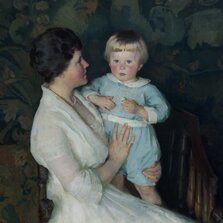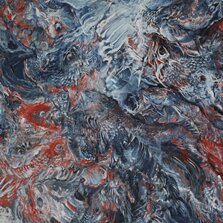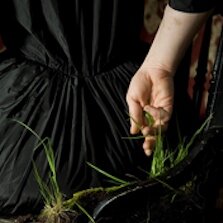
The Permanent Collection at Danforth Art consists of approximately 3,500 objects in all media. The Museum has been building the collection since its founding in 1975, and actively collects and holds examples of American Art in all media from the early nineteenth century to the present day. The collection includes familiar names from American art history as well as significant holdings of contemporary regional art from both established and emerging artists. Danforth Art is proud to be the caretaker of the Meta Vaux Warrick Fuller Special Collection; more information about that collection is available here. To learn more about upcoming opportunities to view or learn about works in our Permanent Collection, please visit our Upcoming Exhibition and Adult Programs/Outreach.
Explore a selection of these works more deeply in this online gallery. For more information about the work (date, medium, whether it is currently on view), please click on the artwork image below to open a page from our collections database. Details of works are shown as thumbnails below; full images are shown on the linked pages.

Gilbert Stuart |

Marie Danforth Page |

Gerrit A. Beneker |
Figuration in American Art
Representations of the figure, particularly through formal portraits, are laden with symbolic meaning. Throughout art history, elements such as pose, costume, and background served as key components in decoding figural representation. Solemnity in pose or elaborateness of dress was meant to convey history, class status, and, more personally, character. Works by Gilbert Stuart, Marie Danforth Page, Gerrit Beneker, and other collection artists from the nineteenth century to the present day depict the myriad ways in which monumentality in figuration can be deployed to create a social identity.
New England Academic Traditions
Boston was a rich cultural capital at the turn of the twentieth century, yet it was also a city that struggled with modernism. However, artists of The Boston School could be both vibrant and progressive, and their work mirrored the time in which it was created. Both the women and men who studied at the School of the Museum of Fine Arts used intensive figure studies to help establish a distinctive style that positioned Boston as a city wavering on the cusp of the modern era. While some artists were more eager for change than others, creating a truly modern art in New England worked a circuitous path before blossoming in a number of new and expressive manifestations. Perhaps surprisingly, one of the places where the historical and the modern met was through the landscape. Works by artists such as George Hawley Hallowell reference a more unsettled, and modern, landscape view.

Karl Zerbe |

Hyman Bloom |

Suzanne Hodes |
Painting in Boston
Boston Expressionism, a movement defined by an attention to figural abstraction, was deeply rooted in early twentieth-century symbolism and expressionism in Europe. Working in Boston from the late 1930s through the 1950s, many of these artists studied under Karl Zerbe at the School of the Museum of Fine Arts, although multiple generations of artists working in this expressive vein have followed. Boston Expressionists embraced different aspects of expressionism—the social, the religious, the mystical—but all found commonality in the need to convey a personal and emotional reaction through expressive mark-making. At a time when abstraction was the dominant trend in the art world, these artists retained an element of the figure in their work, using the figure as an expression of the struggle with identifying and codifying an artistic identity.

Robert Ferrandini |

Richard Yarde |

Toni Pepe |
Contemporary, Regional Art
Danforth Art is committed to the work of contemporary regional artists, and is proud to be the home for the Annual Juried Exhibition and the New England Photography Biennial. The museum has significant holdings across media from artists who worked to shape a vibrant artistic tradition in and around Boston, and those who are actively engaged with the art scene throughout New England. Their works reference art historical traditions while remaining boldly contemporary.
Situs togel yang resmi di indonesia dengan bet 100 perak saja anda bisa mendapatkan hadiah 4D 10 Juta. Jika Anda mencari peluang besar dengan modal kecil, situs togel resmi ini adalah pilihan yang tepat. dengan hanya 100 perak, Anda dapat berpartisipasi dalam permainan togel yang menantang dan memiliki kesempatan untuk membawa pulang hadiah 4D 10 juta rupiah. Togel Online menawarkan berbagai pasaran terkenal, seperti Hongkong dan Singapura, dengan sistem keamanan yang menjamin transaksi cepat dan aman. Anda juga bisa menikmati berbagai fitur menarik seperti diskon besar-besaran dan bonus new member yang menguntungkan.
Dalam dunia toto togel, investasi berarti menaruh banyak nomor untuk meningkatkan peluang menang. Pemain cerdas biasanya mengombinasikan strategi ini dengan bonus dan promosi dari Bandar Togel Terpercaya yang menawarkan saldo tambahan. Dengan cara ini, kesempatan untuk meraih profit menjadi sangat tinggi. hanya di sini modal rendang ke untungan sangat tinggi
Temukan pengalaman bermain Bo Togel Hadiah 2d 200rb yang aman dan menyenangkan di platform judi online terpercaya. Dengan berbagai bonus menarik, Anda dapat meningkatkan peluang menang dan menikmati keuntungan lebih banyak. Situs ini menyediakan pasaran togel lengkap serta layanan customer support yang siap membantu 24 jam.
Untuk menang di slot gacor setiap hari, penting memahami mekanisme permainan dan memperhatikan pola kemenangan. Manfaatkan bonus dan promosi yang ditawarkan oleh Situs Slot Gacor, seperti free spin atau bonus deposit, untuk memperpanjang waktu bermain tanpa menghabiskan modal terlalu cepat. Tetapkan batasan modal dan jangan tergoda untuk terus bermain saat mengalami kekalahan beruntun.
Bocoran slot Mahjong gacor dengan scatter hitam di 2024 menjadi incaran para pemain yang ingin meningkatkan peluang menang mereka. Dengan memanfaatkan Mahjong Ways 2, pemain bisa mencari waktu dan strategi terbaik untuk bermain dan meraih scatter hitam yang membawa keuntungan besar. Pemain berpengalaman menyarankan untuk bermain pada jam-jam tertentu agar peluang mendapatkan scatter semakin tinggi.
Bermain slot dengan modal kecil kini semakin mudah berkat adanya Slot Min Depo 5k. Dengan deposit terjangkau ini, pemain dapat menikmati berbagai jenis permainan slot tanpa perlu khawatir menghabiskan banyak uang. Ini sangat cocok untuk pemain baru yang ingin mencoba peruntungan dengan modal minim.
Dalam dunia permainan daring, RTP slot online adalah istilah yang sering dibicarakan. Tingkat RTP atau Return to Player ini menentukan seberapa besar peluang pemain untuk memenangkan kembali uang yang dipertaruhkan. Oleh karena itu, banyak pemain yang mencari informasi tentang slot gacor yang menawarkan RTP slot tertinggi. Hari ini, ada berbagai pilihan slot yang menunjukkan angka RTP tinggi, memberikan harapan bagi para penjudi untuk meraih kemenangan besar.
Agen slot gacor Slot777 yang tersedia di Situs Slot Gacor memberikan pengalaman bermain dengan sensasi nyata seperti di kasino sungguhan. Grafis berkualitas tinggi dan efek suara yang realistis membuat permainan semakin hidup. Pemain bisa merasakan adrenalin saat mendapatkan kombinasi kemenangan besar. Dengan fitur live chat, pemain juga bisa berinteraksi dengan pemain lain saat bermain. Semua ini menciptakan pengalaman bermain yang tidak terlupakan.
Slot gacor Thailand dipahami sebagai simbol sistem hiburan yang berjalan tanpa hambatan. Slot Thailand menunjukkan bagaimana pengaturan ruang digital mendukung hiburan daring. Slot server Thailand berperan penting menjaga stabilitas pengalaman pengguna. Banyak orang menghubungkan situs slot Thailand dengan pusat data hiburan terkini. Maka hiburan online interaktif kini sudah menjadi bagian kehidupan sehari-hari.
Permainan di situs toto slot Megaways adalah salah satu jenis slot yang menawarkan cara menang yang lebih banyak dibandingkan slot biasa. Dengan sistem Megaways, jumlah simbol pada setiap gulungan dapat berubah-ubah, menciptakan ribuan kemungkinan kombinasi kemenangan. Banyak pemain menyukai slot ini karena fitur uniknya yang memberikan peluang lebih besar untuk menang besar. Selain itu, banyak situs Toto kini menawarkan berbagai varian slot Megaways dari provider ternama. Memahami cara kerja slot ini bisa membantu pemain meningkatkan peluang mendapatkan jackpot besar.
Pola angka dalam Toto Macau dapat ditemukan dengan menganalisis Live Draw Macau secara mendalam. Setiap Keluaran Macau yang diumumkan dapat memberikan petunjuk mengenai tren angka yang berpotensi muncul kembali. Dengan memahami Result Macau dari berbagai periode sebelumnya, pemain bisa menentukan angka taruhan dengan lebih baik. Oleh karena itu, mengikuti Live Draw Macau adalah salah satu cara terbaik untuk meningkatkan peluang kemenangan dalam Toto Macau.
Salah satu faktor penting dalam toto slot adalah RTP (Return to Player) yang menentukan persentase kemenangan pemain. Situs toto resmi selalu menyediakan permainan dengan RTP tinggi yang memberikan peluang menang lebih besar dibandingkan slot biasa. Toto togel juga menawarkan berbagai fitur tambahan seperti bonus multiplier yang bisa memperbesar kemenangan pemain. Selain itu, memilih game dengan volatilitas rendah bisa menjadi strategi cerdas bagi pemain yang ingin bermain lebih lama dengan modal yang sama. Dengan memperhatikan RTP dan strategi bermain, keuntungan dari permainan toto slot bisa lebih maksimal.
Statistik keluaran angka togel menjadi alat bantu yang sangat berharga untuk pemain dalam menyusun strategi taruhan. Di Togel158, tersedia berbagai fitur statistik lengkap yang mudah digunakan oleh pemula maupun profesional. Informasi seperti angka panas, angka dingin, dan pola keluaran bisa diakses dengan cepat. Dengan data lengkap, pemain bisa mengambil keputusan lebih matang dan meningkatkan peluang menang. Fitur ini memberikan keunggulan kompetitif dalam dunia togel online.
Inovasi digital membuat Live draw macau semakin mudah diakses oleh pemain modern. Result macau kini bisa ditonton melalui berbagai aplikasi dengan tampilan interaktif. Keluaran macau juga bisa diunduh langsung sehingga analisis jadi lebih cepat. Semua inovasi ini membuat pengalaman bermain Toto macau semakin praktis dan menyenangkan.